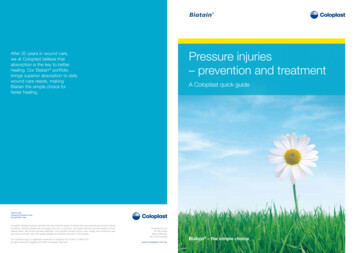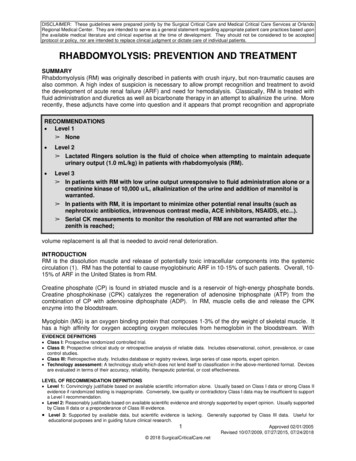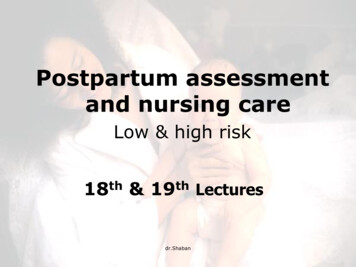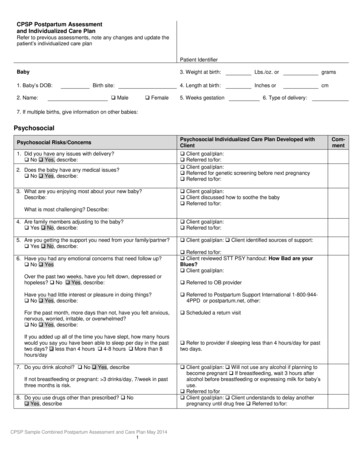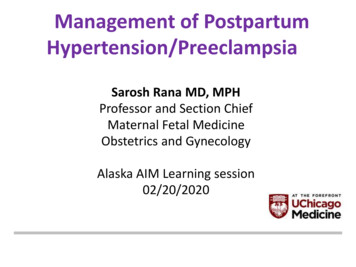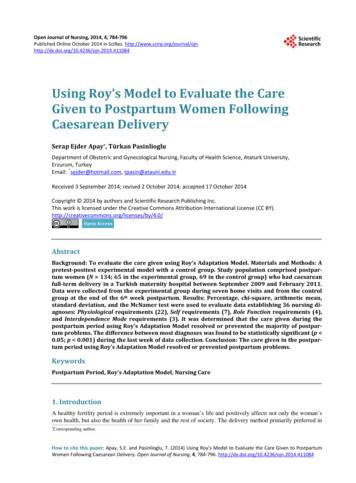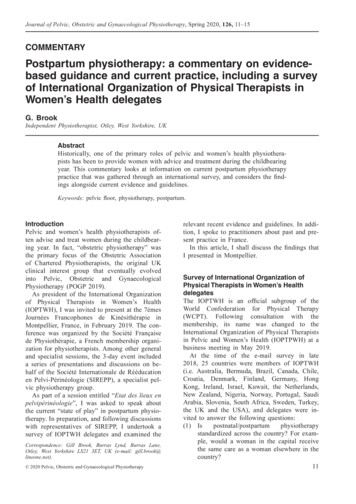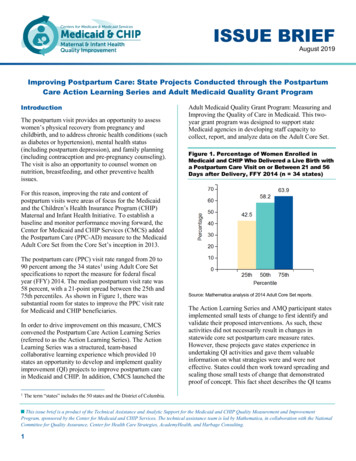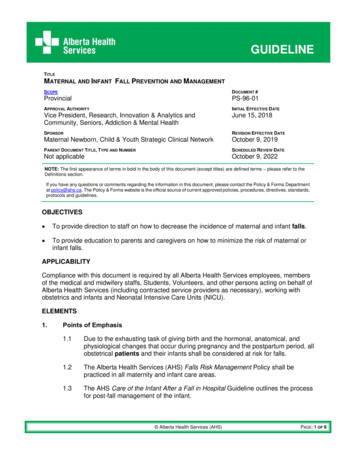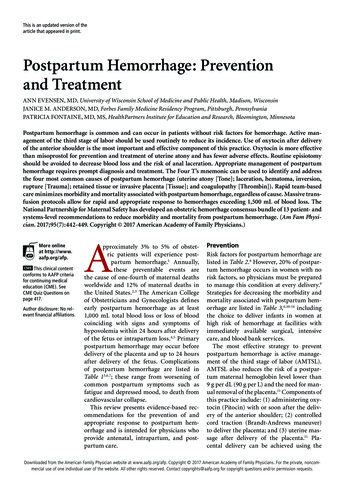
Transcription
This is an updated version of thearticle that appeared in print.Postpartum Hemorrhage: Preventionand TreatmentANN EVENSEN, MD, University of Wisconsin School of Medicine and Public Health, Madison, WisconsinJANICE M. ANDERSON, MD, Forbes Family Medicine Residency Program, Pittsburgh, PennsylvaniaPATRICIA FONTAINE, MD, MS, HealthPartners Institute for Education and Research, Bloomington, MinnesotaPostpartum hemorrhage is common and can occur in patients without risk factors for hemorrhage. Active management of the third stage of labor should be used routinely to reduce its incidence. Use of oxytocin after deliveryof the anterior shoulder is the most important and effective component of this practice. Oxytocin is more effectivethan misoprostol for prevention and treatment of uterine atony and has fewer adverse effects. Routine episiotomyshould be avoided to decrease blood loss and the risk of anal laceration. Appropriate management of postpartumhemorrhage requires prompt diagnosis and treatment. The Four T’s mnemonic can be used to identify and addressthe four most common causes of postpartum hemorrhage (uterine atony [Tone]; laceration, hematoma, inversion,rupture [Trauma]; retained tissue or invasive placenta [Tissue]; and coagulopathy [Thrombin]). Rapid team-basedcare minimizes morbidity and mortality associated with postpartum hemorrhage, regardless of cause. Massive transfusion protocols allow for rapid and appropriate response to hemorrhages exceeding 1,500 mL of blood loss. TheNational Partnership for Maternal Safety has developed an obstetric hemorrhage consensus bundle of 13 patient- andsystems-level recommendations to reduce morbidity and mortality from postpartum hemorrhage. (Am Fam Physician. 2017;95(7):442-449. Copyright 2017 American Academy of Family Physicians.)More onlineat http://www.aafp.org/afp.CME This clinical contentconforms to AAFP criteriafor continuing medicaleducation (CME). SeeCME Quiz Questions onpage 417.Author disclosure: No relevant financial affiliations.Approximately 3% to 5% of obstetric patients will experience postpartum hemorrhage.1 Annually,these preventable events arethe cause of one-fourth of maternal deathsworldwide and 12% of maternal deaths inthe United States.2,3 The American Collegeof Obstetricians and Gynecologists definesearly postpartum hemorrhage as at least1,000 mL total blood loss or loss of bloodcoinciding with signs and symptoms ofhypovolemia within 24 hours after deliveryof the fetus or intrapartum loss.4,5 Primarypostpartum hemorrhage may occur beforedelivery of the placenta and up to 24 hoursafter delivery of the fetus. Complicationsof postpartum hemorrhage are listed inTable 13,6,7; these range from worsening ofcommon postpartum symptoms such asfatigue and depressed mood, to death fromcardiovascular collapse.This review presents evidence-based recommendations for the prevention of andappropriate response to postpartum hemorrhage and is intended for physicians whoprovide antenatal, intrapartum, and postpartum care.PreventionRisk factors for postpartum hemorrhage arelisted in Table 2.8 However, 20% of postpartum hemorrhage occurs in women with norisk factors, so physicians must be preparedto manage this condition at every delivery.9Strategies for decreasing the morbidity andmortality associated with postpartum hemorrhage are listed in Table 3,6,10-14 includingthe choice to deliver infants in women athigh risk of hemorrhage at facilities withimmediately available surgical, intensivecare, and blood bank services.The most effective strategy to preventpostpartum hemorrhage is active management of the third stage of labor (AMTSL).AMTSL also reduces the risk of a postpartum maternal hemoglobin level lower than9 g per dL (90 g per L) and the need for manual removal of the placenta.11 Components ofthis practice include: (1) administering oxytocin (Pitocin) with or soon after the delivery of the anterior shoulder; (2) controlledcord traction (Brandt-Andrews maneuver)to deliver the placenta; and (3) uterine massage after delivery of the placenta.11 Placental delivery can be achieved using the442AmericanFamilyPhysicianwww.aafp.org/afp95, Number7 private,Aprilnoncom1, 2017Downloadedfrom theAmericanFamily Physician website at www.aafp.org/afp.Copyright 2017 American Academy ofVolumeFamily Physicians.For the mercial use of one individual user of the website. All other rights reserved. Contact copyrights@aafp.org for copyright questions and/or permission requests.
Postpartum HemorrhageBrandt-Andrews maneuver, in which firm traction onthe umbilical cord is applied with one hand while theother applies suprapubic counterpressure15 (eFigure A).The individual components of AMTSL have been evaluated and compared. Based on existing evidence, the mostimportant component is administration of a uterotonicdrug, preferably oxytocin.12,16 The number needed to treatto prevent one case of hemorrhage 500 mL or greater is 7for oxytocin administered after delivery of the fetal anterior shoulder or after delivery of the neonate comparedwith placebo.16 The risk of postpartum hemorrhage is alsoreduced if oxytocin is administered after placental delivery instead of at the time of delivery of the anterior shoulder.17 Dosing instructions are provided in Table 4.6An alternative to oxytocin is misoprostol (Cytotec), aninexpensive medication that does not require injectionand is more effective than placebo in preventing postpartum hemorrhage.12 However, most studies have shownthat oxytocin is superior to misoprostol.12,18 Misoprostolalso causes more adverse effects than oxytocin—commonly nausea, diarrhea, and fever within three hours ofbirth.12,18The benefits of controlled cord traction and uterinemassage in preventing postpartum hemorrhage are lessclear, but these strategies may be helpful.15,19,20 ControlledTable 1. Complications of PostpartumHemorrhageAnemiaDeathAnterior pituitary ischemiawith delay or failure oflactation (i.e., Sheehansyndrome or postpartumpituitary necrosis)Dilutional coagulopathyBlood transfusionFatigueMyocardial ischemiacord traction does not prevent severe postpartum hemorrhage, but reduces the incidence of less severe bloodloss (500 to 1,000 mL) and reduces the need for manualextraction of the placenta.21Diagnosis and ManagementDiagnosis of postpartum hemorrhage begins with recognition of excessive bleeding and targeted examination to determine its cause (Figure 16). Cumulative bloodloss should be monitored throughout labor and delivery and postpartum with quantitative measurement, ifTable 3. Strategies to Reduce Morbidity andMortality from Postpartum HemorrhageReadiness by every unitHave a hemorrhage cart with medications, supplies, checklist,and instruction cards immediately availableEstablish a response team and know who to call when help isneededEstablish massive and emergency release transfusion protocolsInstitute unit education on protocols and run unit-based drillsRecognition and prevention efforts for every patientAntenatal assessmentScreen for and treat anemia antenatallyScreen for sickle cell disease and thalassemia in women ofAfrican, Southeast Asian, or Mediterranean descentObtain sonograms for women at high risk of invasive placentaPerform delivery in facility with blood bank and in-housesurgical services if the patient has a high risk of hemorrhageIdentify Jehovah’s Witnesses and other patients who declineblood productsIntrapartum managementOrthostatic hypotensionUse active management of the third stage of labor in everydeliveryPostpartum depressionAvoid routine episiotomyAvoid instrumented deliveries, especially forcepsInformation from references 3, 6, and 7.Use perineal warm compressesMeasure cumulative blood loss and track postpartum vital signsResponse for every hemorrhageUse an emergency management plan with checklistsTable 2. Risk Factors for PostpartumHemorrhageProvide support program for patients, families, and staffReporting and systems learning for every unitEstablish a culture of huddles and postevent debriefsAntepartum hemorrhageMaternal obesityComplete a multidisciplinary review for systems issuesAugmented laborMultifetal gestationEstablish a perinatal quality improvement committeeChorioamnionitisPreeclampsiaFetal macrosomiaPrimiparityMaternal anemiaProlonged laborInformation from reference 8.April 1, 2017 Volume 95, Number 7Adapted with permission from Council on Patient Safety in Women’sHealth Care. Obstetric hemorrhage patient safety bundle. ety-bundles/obstetrichemorrhage/ [login required]. Accessed October 16, 2016. Additionalinformation from references 6, and 11 through 14.www.aafp.org/afp American Family Physician 443
Postpartum HemorrhageTable 4. Medications Used for Prevention and Treatment of Postpartum aindications and cautionsPrevention: 10 IU IM or 5 to10 IU IV bolus Overdose or prolonged use can cause waterintoxicationFirst-line agentOxytocin (Pitocin)Treatment: 20 to 40 IU in 1 Lnormal saline, infuse 500 mL over10 minutes then 250 mL per hourPossible hypotension with IV use followingcesarean deliverySecond-line agentsCarboprost (Hemabate),a prostaglandin F2-alphaanalogue250 mcg IM or into myometrium,repeated every 15 to 90 minutesfor a total dose of 2 mg– Avoid in patients with asthma or significantrenal, hepatic, or cardiac diseaseMethylergonovine(Methergine)0.2 mg IM, repeat every two tofour hours– Avoid in hypertensive disorders ofpregnancy, including chronic hypertensionUse with caution in patients with humanimmunodeficiency virus infection who arereceiving protease inhibitorsMisoprostol (Cytotec),†a prostaglandin E1analoguePrevention: 600 mcg orallyTranexamic acid(Cyklokapron)†1 g intravenously over 10 minutes,may be repeated after 30minutesTreatment: 800 to 1,000 mcgrectally or 600 to 800 mcgsublingually or orallyUse only whenoxytocin isnot available Use with caution in patients withcardiovascular disease- Use within three hours of onset of bleedingUse with caution in patients with renalimpairment and with other clotting factorssuch as prothrombin complex concentrateIM intramuscularly; IV intravenous; NA not available.*—Estimated retail price based on information obtained at http://online.lexi.com/action/home (login required; accessed June 10, 2016). Generic price listed first;brand price listed in parentheses.†—Misoprostol and tranexamic acid are not approved by the U.S. Food and Drug Administration for use in prevention or treatment of postpartum hemorrhage.Adapted with permission from Evensen A, Anderson J. Chapter J. Postpartum hemorrhage: third stage pregnancy. In: Leeman L, Quinlan J, DresangLT, eds. Advanced Life Support in Obstetrics: Provider Syllabus. 5th ed. Leawood, Kan.: American Academy of Family Physicians; 2014:11.possible.22 Although some important sources of bloodloss may occur intrapartum (e.g., episiotomy, uterinerupture), most of the fluid expelled during delivery ofthe infant is urine or amniotic fluid. Quantitative measurement of postpartum bleeding begins immediatelyafter the birth of the infant and entails measuring cumulative blood loss with a calibrated underbuttocks drape,or by weighing blood-soaked pads, sponges, and clots;combined use of these methods is also appropriate forobtaining an accurate measurement.22 Healthy pregnantwomen can typically tolerate 500 to 1,000 mL of bloodloss without having signs or symptoms.9 Tachycardiamay be the earliest sign of postpartum hemorrhage.Orthostasis, hypotension, nausea, dyspnea, oliguria, andchest pain may indicate hypovolemia from significanthemorrhage. If excess bleeding is diagnosed, the Four T’smnemonic (uterine atony [Tone]; laceration, hematoma,inversion, rupture [Trauma]; retained tissue or invasiveplacenta [Tissue]; and coagulopathy [Thrombin]) canbe used to identify specific causes (Table 56). Regardlessof the cause of bleeding, physicians should immediately444 American Family Physiciansummon additional personnel and begin appropriateemergency hemorrhage protocols.TONE (UTERINE ATONY)Uterine atony is the most common cause of postpartumhemorrhage.9 Brisk blood flow after delivery of the placenta unresponsive to transabdominal massage shouldprompt immediate action including bimanual compression of the uterus and use of uterotonic medications(Table 4 6). Massage is performed by placing one hand inthe vagina and pushing against the body of the uteruswhile the other hand compresses the fundus from abovethrough the abdominal wall (eFigure B).Uterotonic agents include oxytocin, ergot alkaloids,and prostaglandins. Oxytocin is the most effectivetreatment for postpartum hemorrhage, even if alreadyused for labor induction or augmentation or as partof AMTSL.8,23,24 The choice of a second-line uterotonicshould be based on patient-specific factors such as hypertension, asthma, or use of protease inhibitors. Althoughit is not a uterotonic, tranexamic acid (Cyklokapron)www.aafp.org/afpVolume 95, Number 7 April 1, 2017
Postpartum HemorrhageMechanism of actionAdverse effectsCost*of the clot.27 The involved area should beirrigated and hemostasis achieved by ligating bleeding vessels, placing figure-of-eightsutures, and creating a layered closure, or byusing any of these methods alone.Uterine inversion is rare, occurring in only0.04%of deliveries, and is a potential causeImproves uterine contractility byNausea, vomiting,NA ( 270) forof postpartum hemorrhage.27 AMTSL doesincreasing the number of oxytocinand diarrhea250 mcg ofreceptors and causes vasoconstrictioninjectablenot appear to increase the incidence of utersolutionine inversion, but invasive placenta does.27,28Causes vasoconstriction and contractsNausea, vomiting, 9 (NA) forThe contributions of other conditions suchsmooth muscles and upper and lowerand increased0.2 mg ofas fundal implantation of the placenta,segments of the uterus tetanicallyblood pressureinjectablefundal pressure, and undue cord tractionso
01.04.2017 · care minimizes morbidity and mortality associated with postpartum hemorrhage, regardless of cause. Massive trans - Massive trans - fusion protocols allow for rapid and appropriate response to .
